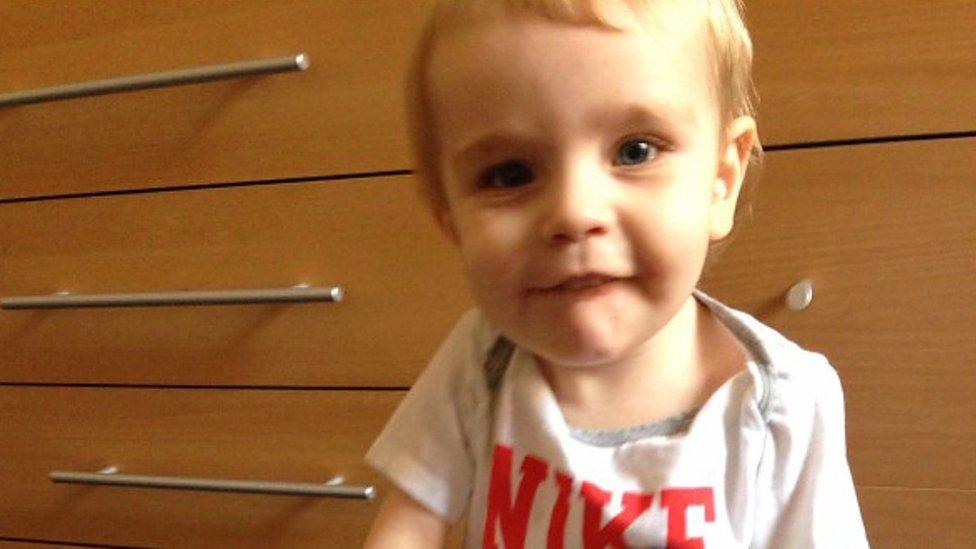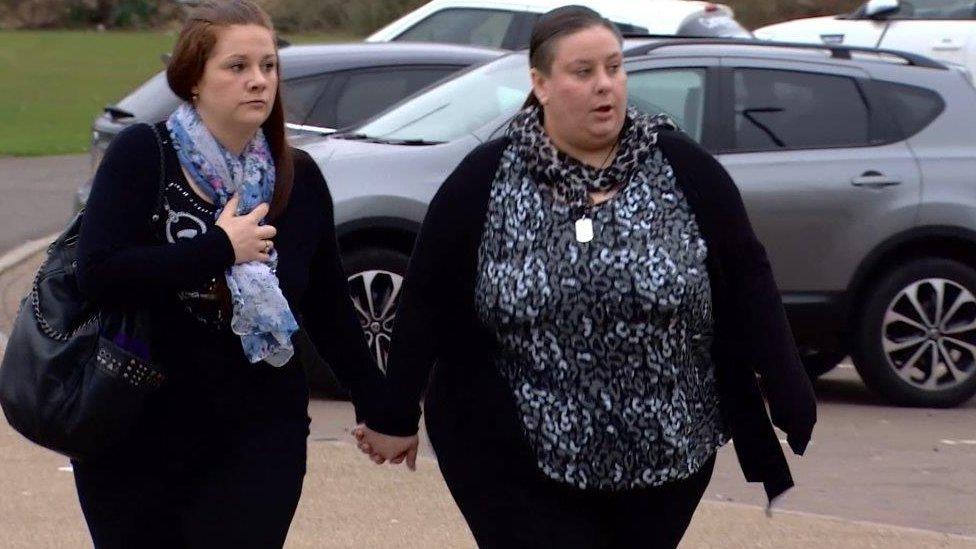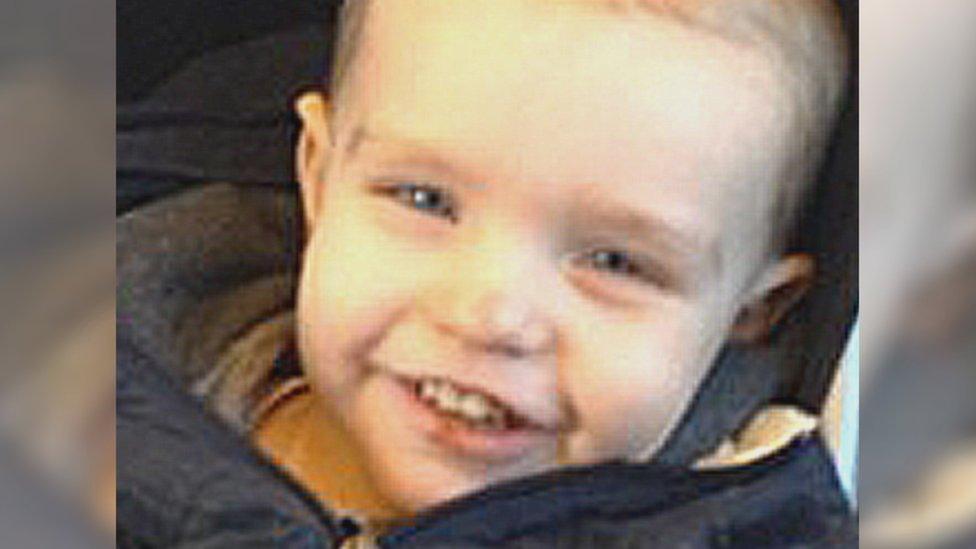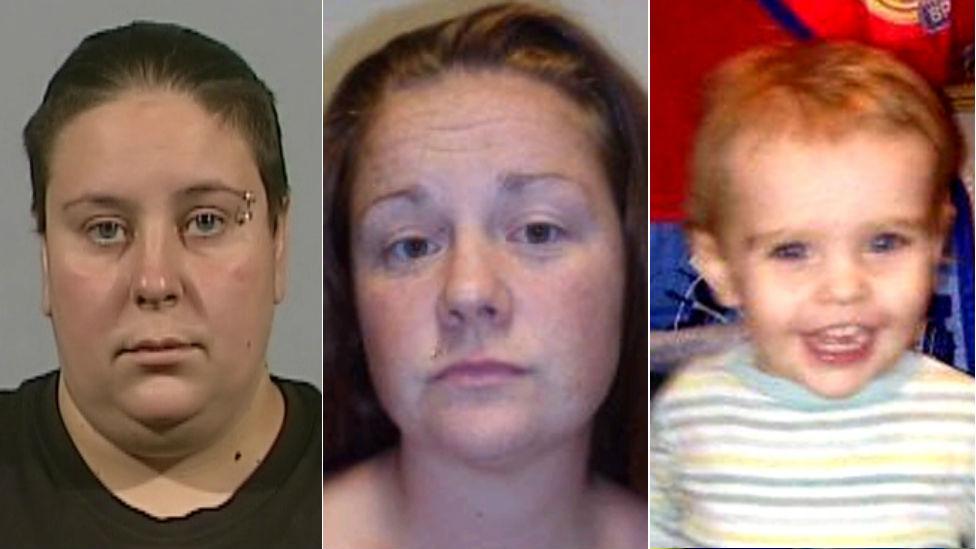Liam Fee murder: Case review highlights 'missed opportunities'
- Published

Liam died in March 2014 with injuries similar to those those found on road crash victims
Child protection officials "missed opportunities" to intervene in the case of Fife toddler Liam Fee, a review into his death has found.
The Significant Case Review, external was launched after the two-and-a-half year old's mother Rachel Fee and her partner Nyomi Fee were convicted of murder.
He was killed at his home in Thornton, near Glenrothes, Fife, in March 2014.
The report said his carers were "manipulative, devious and hindered services".
The review by Dr Jacqueline Mok said they used "disguised compliance" to play one professional against another.
Rachel Fee, or Trelfa, now 32, and her civil partner Nyomi Fee, 31, had denied killing Liam, blaming his death on one of two other young boys also in their care.
They were convicted of murder and a catalogue of abuse towards Liam and other children, including imprisoning one in a home-made cage and tying another naked to a chair in a dark room with snakes and rats.
Liam was found dead with heart injuries similar to those found on road crash victims after a severe blunt force trauma to his chest and abdomen.
Pathologists found more than 30 external injuries on the toddler's body and fractures to his upper arm and thigh.
'Tragic outcome'
Independent chair of Fife's Child Protection Committee Alan Small said: "Rachel Trelfa (Fee) and Nyomi Fee not only took the life of their child, but did their best to hinder the services that were there to help him.
"We deeply regret that our services did not do more to support Liam, and potentially prevent the tragic outcome of this case."
He said the review painted a picture of services that struggled to see through the actions of "devious and manipulative parents".
"There were missed opportunities across services to intervene and provide support to the family and services are aware that they could have done better to support Liam."

Analysis by Reevel Alderson BBC Scotland's Home Affairs correspondent

Rachel and Nyomi Fee were convicted of murdering Liam at their house in Fife
One of the questions raised by the case of Liam Fee has been "could anyone have saved him?"
That was the main aim of the significant case review.
The answer quite clearly says there were missed opportunities to provide support for the family.
Yes, the review says, Liam's mother and her partner were manipulative, devious and hindered services.
But the report, whose findings raise significant criticisms of Fife Council's social work department, says there was a "lack of professional curiosity".
Explanations provided by the mother and her partner were, at times, accepted without challenge.
It adds that insufficient attention was paid to existing available information, which was neither reviewed nor considered before decisions were taken.
Among professionals who dealt with the family, there was inadequate understanding of the roles and responsibilities of other agencies, it says.
There was no clear understanding who was in charge of the case.
The council says that since 2014, significant improvements have been made across all services.
But Liam Fee's name remains on a tragic list of children failed by the system, whose deaths also led to inquiries which came up with very similar conclusions.

Missed opportunities

The report said two important opportunities for assessment and intervention were missed.
The first was when a social worker and a police officer police officer attended the house in early 2013 after a report from his childminder.
She was concerned the toddler was being hurt by someone.
Liam's mother and her partner were said to have given a "plausible explanation" that he bumped his head.
This led to the conclusion that no crime had been committed because the explanation fitted the injury seen.
The report says further work could have been done with the childminder to help provide a more comprehensive assessment.
During the second investigation, the child's nursery raised concerns about Liam "pinching himself".
Abuse was suspected but the medical opinion was not definitive.
The clinicians accepted the mother's explanation that he was self-harming.
The report said that for professionals to have accepted the mother's explanation that the injuries were self-inflicted, without further robust enquiries, led to an "incomplete assessment".
It also said that Liam's weight loss was not recognised at the medical examination and child abuse and neglect were not considered.
The review concludes: "Had all the concerns been taken into account, the balance of probability would have led to the conclusion that the injuries and concerns were likely to be the result of abuse."

Liam Fee timeline

Liam died at his home in Thornton, near Glenrothes, in Fife
August 2011 - Liam Fee is born in Ryton, about eight miles west of Newcastle-upon-Tyne.
December 2011 - His mother Rachel Trelfa, as she was then, and Nyomi Fee move after Rachel leaves baby Liam's father.
Early 2012 - The couple stay in a Travelodge at first and then move to a house at Thornton near Glenrothes.
June 2012 - The pair enter into a civil partnership, with Rachel taking her partner's name
January 2013 - Liam is assigned a case worker at Fife social work after reports from his childminder on numerous injuries. A police officer and a social worker visit the family and accept Trelfa and Fee's "plausible explanation" that he bumped his head.
April 2013 - Liam's case worker goes off sick and no-one else is assigned to monitor the family.
June 2013 - Social work become involved again when the nursery raises concerns about Liam "pinching himself". Police and social work take the view that they are not adult marks, but there are still "concerns".
22 March 2014 - Liam dies in a bedroom of the family home.

Devious and manipulative
The review said Rachel and Nyomi Fee's engagements with child care service were complex.
Sometimes they would engage and often they would not.
They would frequently change appointments and received positive reports whenever a visit was "pre-arranged".
The review said they used "disguised compliance", welcoming offers of help and support but never taking them up.
Reaction to the report
Reacting to the review, Child Protection Committees Scotland (CPCS) said it was a stark reminder that inter-agency communications and reporting systems may not always link up or talk to each other effectively to assess and manage risk.
However, David Cumming of the CPCS said abusive parents or carers could be "manipulative, devious and covert" which made the job of child protection officials very difficult.
He said: "Failures within child protection systems may be compounded in cases where a child's parents or carers go to great lengths to conceal the abuse of the children in their care, or provide seemingly valid reasons for things like injury, unusual behaviour or weight loss.
"This misreporting and concealment is what we call 'disguised compliance', and it can be very difficult for professionals from different agencies to join the dots when abusive parents are very clever at hiding or explaining away their actions."
Joanna Barrett, acting national head for NSPCC Scotland, the failings and missed opportunities highlighted by the review were "highly disturbing".
She said: "For example, it is extremely worrying that a child as vulnerable as Liam was able to fall off the radar because a member of staff had gone off sick and no-one else was assigned his case until even more concerns were raised.
"It's vital that the necessary improvements are made to prevent other children from suffering as Liam did before his murder - his short life scarred by neglect, abuse and violence at the hands of those who should have been caring for him."
- Published6 July 2016
